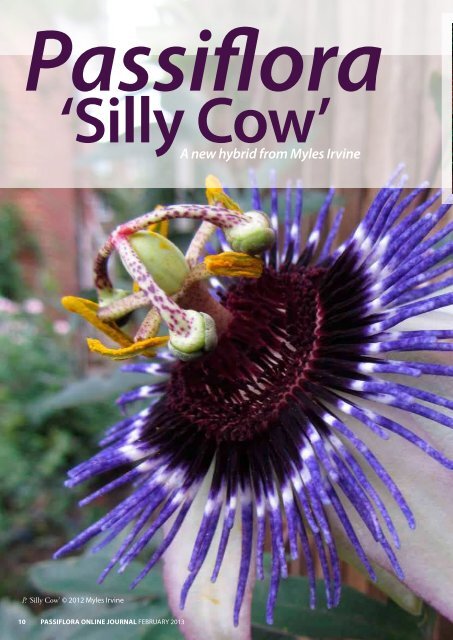Issue 3 2013 Lo-res PDF - Passion Flowers
Issue 3 2013 Lo-res PDF - Passion Flowers
Issue 3 2013 Lo-res PDF - Passion Flowers
Create successful ePaper yourself
Turn your PDF publications into a flip-book with our unique Google optimized e-Paper software.
Passiflora<br />
‘Silly Cow’<br />
A new hybrid from Myles Irvine<br />
Named in June 2011 in honour of<br />
my dear friend Jana-Marie Štípská.<br />
Image copyright Marie Štípská<br />
Passiflora Online Journal February <strong>2013</strong><br />
11<br />
My particular focus, especially bearing in<br />
mind that the UK has recently come<br />
through two very hard winters, is to breed<br />
hardy polyploid crosses. These cultivars<br />
will never have the exciting palette of vibrant pinks and<br />
reds of the more exotic tropical Passiflora, as generally<br />
they need to have either P. caerulea or P. incarnata in the<br />
parentage to ensure some degree of hardiness. I guess the<br />
nea<strong>res</strong>t we have to a hardy red cultivar is Tim Skimina’s<br />
lovely dark red and white P. ‘Lady Margaret’, but, as with<br />
most plants including P. incarnata in the parentage, our<br />
winters in the UK are too wet for it to be considered<br />
hardy in our climate.<br />
Passiflora ‘Silly Cow’ is one of my new polyploid crosses.<br />
It is a large vigorous free flowering vine and is hardy to<br />
-8°C 18°F or lower. The flowers are sturdy, usually single<br />
but occasionally in pairs; buds held upright, proud of<br />
the foliage, on peduncles up to 16 cm long which bend<br />
under the weight of the flower when it opens; they are<br />
intensely perfumed, up to 13 cm in diameter with strong<br />
corona filaments and petals; the flowers reflex fully and<br />
they stay open for several days; the androgynophore,<br />
anther filaments and style are light green with light violet<br />
speckling that is more intense on the style; there is plenty<br />
of pollen p<strong>res</strong>ent on the well-formed anthers; the sepals<br />
and petals are wide and white with both having variable<br />
light lavender flecks to the edges; the sepals are fleshy with<br />
their abaxial surface being green with light violet flecks<br />
and long claw-like awns; there are dark maroon almost<br />
black eyelash-like inner corona filaments protecting the<br />
androgynophore, a short upright dark maroon intermediate<br />
row, about 5 tiny short intermediate rows then two rows<br />
of strong circumferentially wavy but straight outer corona<br />
filaments up to 6 cm and 8 cm in diameter, both banded<br />
dark maroon in the centre to almost black then with a<br />
slim band of white to light purple then an intense blue<br />
with white flecks to the apex; the bracts are 3cm x 2.3cm,<br />
peduncle up to 15cm; the stems are maroon and strong<br />
and there are attractive shiny dark green leathery leaves up<br />
to 17cm x 20cm with usually three, or sometimes four or<br />
five, wide lobes joined from a quarter to a third of the way<br />
up the leaf; the leaves have wavy edges and strong crimson<br />
veins; petiole 10cm or more; usually one pair 4mm long<br />
petiole glands near middle of petiole. Stipules 2.4cm x<br />
1cm. Fruits rarely, with oval fruit up to 7cm and ripening<br />
to yellow orange.<br />
P. ‘Silly Cow’ © 2012 Myles Irvine<br />
For wholesale enquiries in the UK and Europe please contact<br />
Nick Reece at Jackdaws’ Field Nursery<br />
www.jackdawsfield.co.uk.<br />
10<br />
Passiflora Online Journal February <strong>2013</strong>
















